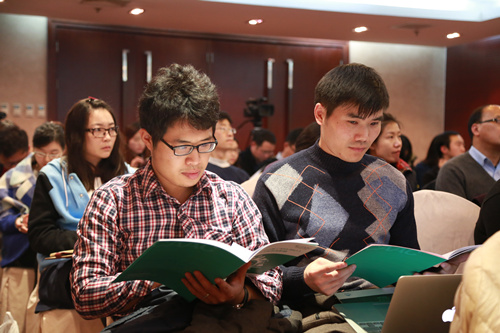


Nov.19th, 2015, Beijing
The secretariat of Clean Air Alliance of China (Innovation Center of Clean-air Solutions) has released the fifth “CAAC Policy Report”: Investment Requirements and Potential Effects of Implementing China’s Air Pollution Prevention and Control Action Plan with the support of Energy Foundation. The report comes from the two-year field research, systematic counting, analysis and calculating by the expert team of Chinese Academy for Environmental Planning (CAEP) and Nanjing University. On the afternoon of November the nineteenth, Professor Dong Zhanfeng of CAEP introduced the analyzing methods, process and results of the report to the experts in finance, experts of the Environmental Protection Departments and journalists. He also took comments from the experts and questions from the journalists.
Investment requirements
The direct investment of implementing China’s Air Pollution Prevention and Control Action Plan (2013-2017) is estimated to be 1.84 trillion yuan, 8% more than the previous estimation of 1.7 trillion yuan. Improving energy structure, preventing and controlling of pollution from mobile sources, industrial sources and non-point mobile sources would cost 284.4Bn, 1,406.766Bn, 91.544Bn and 64.572Bn, respectively. In these four parts controlling pollution from mobile sources is the one that cost the most, which is more than the triple amount of the sum of the other three parts.
Implementing prevention and control action plan in the Jingjinji Region, Yangtze River Delta, and Pearl River Delta would need RMB 249.029Bn, 238.469Bn and 90.358Bn, respectively. The three regions’ investment need on controlling industrial pollution, mobile sources pollution and improving energy structure is illustrated as follows.
Health effects
The report makes quantitative estimation of the health effects of implementing the Action Plan. The report uses the exposure-response relationship of epidemiological analysis method to assess the relation between the health effects and PM2.5. Implementing the Action Plan could achieve the goal of improving air quality. By 2017, there would be a reduction of 110,600 chronic deaths per year. Among all provinces and cities, Hebei is estimated to have the greatest reduction because of the implement of the Action Plan. Of different diseases, acute bronchitis is expected to be most impacted. The reduction of the number of acute bronchitis cases would be much higher than the reduction of death cause by respiratory diseases. This is because the period of acute bronchitis is short, while the period of respiratory diseases is longer. By contrast, major cities such as Beijing, Shanghai and Guangzhou would get the most health effects.
The analysis of the negative effect on life expectancy suggests that successfully implementing the Action Plan could extend life expectancy. In general, the Action Plan could extend life expectancy by an average of 0.24-1.48 years for males and 0.34-3.48 years for females. The Jingjinji Region—especially Beijing—is calculated to have the greatest improvements in overall life span out of all regions in China. Those aged 65 and under will experience greater health improvements than those who are over 65, with average expected improvements ranging from 0.37-3.77 years and 0.2-1.19 years, respectively.
Social and economic influence
Implementing the Control Action Plan is expected to increase China’s GDP by 2.04 trillion yuan and create 2.1993m jobs over the course of five years. The prevention and control investments are expected to increase China’s GDP by 2.84 trillion yuan, adding 3.8031 million jobs. While eliminating outdated industries will result in a negative GDP growth of 776.557 billion yuan and cut 891,800 jobs. Comparing within the three major regions, the Yangtze River Delta region would get the most direct benefit of 278.203 billion yuan. While Jingjinji Region would only get the benefit of 3.566 billion yuan, which is much less than Yangtze River Delta, and Pearl River Delta. This is mainly because the amount of eliminating outdated dated industry is large, and this negative effect would counteract the positive effect brought by environmental investment. On the improvement of major industries, the industries that benefit the most from the Action Plan are transportation equipment manufacturing, general and specialized equipment manufacturing and agriculture, forestry, livestock and aquaculture.
Policy suggestions
The report gives several policy suggestions: Increase financial support to treat pollution from transportation sources, to ensure successful policy implementation. Governments should clarify responsibilities around investment and finance channels. Expand and improve financing channels to implement the Action Plan. Implement policies to encourage the growth of environmental protection companies.
Glad to announce that, the report is ready for download here .



